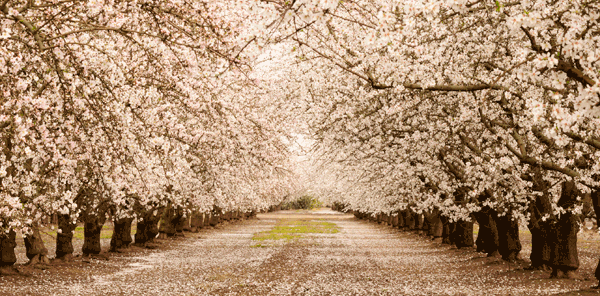According to the U.S. Department of Agriculture, insects pollinate 1/3 of the food we eat, and honey bees pollinate 80% of that. So, nearly every third bite you eat comes to you because of the honey bees’ hard work.
But wait a minute…what is pollination, anyway?
Pollination is very simple – it’s just the transfer of pollen from one flower to another flower of the same kind. When this transfer takes place, the flower is able to produce fruit and seeds. This means that strawberries and watermelons and cucumbers oranges are flowers first, and the only reason we can enjoy their fruits is because they were pollinated – probably by a honey bee! Here are a few pictures of the flowers that some of your favorite foods came from:
 |
| Coffee blossom Photo courtesy Big Tree Farms |
 |
| Nectarine Blossom Photo courtesy www.jomaloniac.com |
 |
| Sunflower blossom |
Now back to the beekeepers…
 |
Cherry blossom Photo courtesy www.grit.com iStockphoto.com/Proxy Minder |
The lemons in your lemonade, the apples in your applesauce, and the cotton in your T-shirt came from plants grown side-by-side in enormous fields like this one:
 |
| Almond orchard Photo courtesy http://www.justalmonds.com/ |
When these plants bloom, the farmer knows that they are ready to be pollinated so they can produce fruit and seeds. Because there are so many plants blooming at the same time in that field, honey bees must be brought to the field to do the job. But who will bring the bees and how will they get there?
 |
| Bees on a truck - can you see the hives beneath the netting? Photo courtesy http://www.georgiabees.blogspot.com/ |
Beekeepers to the rescue!
Beekeepers are people who keep beehives. Some beekeepers have only a few hives that stay in the same place, but other beekeepers have many hives which they move around the country to pollinate plants. When the flowers in the farmers’ fields begin to bloom in the spring, these beekeepers stack their hives onto semi-trucks, strap them down for the ride, and then drive them to the farmer’s field. The farmer pays the beekeepers, renting the number of hives his crop will need to be well-pollinated, and then the beekeepers set their hives in the field or orchard. The bees remain there until they have pollinated the crop (that’s a lot of flowers!), and then the beekeepers load the hives onto the truck again to drive to the next field in need of pollination. Meanwhile, the flowers in the first field can produce fruit and seeds which the farmer can harvest and ship to the restaurants and grocery stores where we can find them!
So this is how the honey bees and the beekeepers who keep them bring us nearly 1/3 of our food!
Watch Pollen Nation by Singeli Agnew and Joshua Fisher (http://www.pollennationthemovie.com/) for a a great video on the importance of honey bee pollination.
“Bee in the Know”: Honey bees pollinate more than 90 different crops in the United States.

No comments:
Post a Comment
Thank you for your comment/question! We are busy buzzing across American spreading the sweet news about honey and beekeeping, but we will do our best to respond in the next 24 hours. We appreciate your patience!